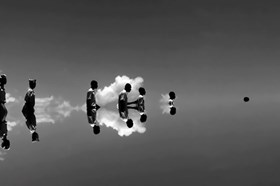cape reviews
Taylor Unpicks the Jungle: A review of Mumbo Jumbo
Michael Taylor at Whatiftheworld / Gallery
By M Blackman01 November - 01 December. 0 Comment(s)

Michael Taylor
Detail of 'Looking for Trouble',
2012.
Painting
120x157cm.
Setting aside the idea of the personal being political (or as Georgina Gratrix insisted recently that ‘puppies are political’) the current trend in painting is overtly apolitical. Although there is a certain amount of hat-raising to political concerns in painting today, most young South African painters have turned their backs on political statements. This may seem surprising considering the controversy surrounding Brett Murray’s The Spear and Ayanda Mabalula’s response Umshini Wam (Weapon of Mass Destruction). Yet these are aberrations in painting at the moment.
There are, it would now seem, two distinct schools of painting emerging in South Africa that consciously shun the last forty or so years of local art history. On the one hand there is a school that seems to follow a largely abstract expressionist trend, marked by a rather over-simplified synchronic recourse.
art events calendar
VIEW FULL CALENDARbuy art prints
edition of 25: R3,500.00
About Editions for ArtThrob
Outstanding prints by top South African artists. Your chance to purchase SA art at affordable prices.
FIND OUT MORE Editions for artthrobOn the other there are painters who have chosen a figurative approach. This school marks itself as being based on an engagement with broader range of art historical concerns. It is a trend that is inward-looking in that it seems to hold painting to be its first concern. It is also overtly syncretic in that it seeks to amalgamate and communicate with a vast array of cultural languages and art movements.
Michael Taylor is perhaps one of the latter movement’s leading exponents. His latest exhibition, ‘Mumbo Jumbo’, at the whatiftheworld/gallery, confirms this. Explicitly satirical and dismissive (another characteristic that marks out this school), Taylor nevertheless is engaged in marked painterly ‘discussions’ with both historical forms and ideas. For example, Looking for Trouble depicts a hiker standing in the romantic pose of Casper David Friedrich’s The Wanderer. Yet the painting, with its title, seems to act as a warning. The figure is not, as is often said of Friedrich’s, contemplating the Kantian sublime (Kant’s attempt to prove that rationality has it limits). Instead Taylor’s figure confronts a jungle whose dangers rationality is all too well-equipped to judge.
The painting comes close in both theme and palette to Taylor’s American contemporary Danna Schutz and in particular seems to reference her Death Comes to Us All. Yet Taylor escapes Schutz’s overtly moralizing cautionary tale. In Taylor there is no accusation pointed at the politically and socially constructed world, which in Schutz is represented in the road, the cigarette and an allusion to mechanization. Instead Taylor’s finger seems pointed at a personal collusion with the system itself – it may be a jungle out there but one’s involvement with this jungle is precisely what creates it. In Stick to What You Know, a merry band of hipsters stride down what seems to be a jungle path, one of them incongruously eating an ice-cream. Their mannerisms depict a naïve self-assuredness that can only suggest the precursor to a self-induced fall of tragic dimensions.
At the centre of Taylor’s work has always been a satirical undermining of consumerism and its façades. In his earlier God is dashing. He is French you Know the mustachioed absurdity with quasi-military shirt was a playful finger in the direction of social construction and fashionable hierarchies. Again in ‘Mumbo Jumbo’, Taylor is concerned with a critique of social construction and yet his latest work somehow marks a hiatus in this practice. For there is something, although equally satirical, more personal and, in a peculiar way, more disconcerting in his latest works.
A motif of oversized hands seems to run through almost all of the figurative works. The hands, large and cumbersome, seem to connote an impotent helplessness to grasp subtleties both emotional and physical. Seemingly the final word on this is the charcoal work Every Man is an Island where the hiker of the previous painting sits in the jungle helpless and dejected on a rock by a stream. His hands, wearied and oversized, hang impotently at his knees. Here the moment of romantic engagement with nature has gone and has seemingly been replaced with another romantic theme: feelings of helpless futility.
If there is a flaw on ‘Mumbo Jumbo’ then it is that, in some moments, a slightly over-zealous expressionism is evident in the jungles that are both backdrops and subjects. At times, the marks are little too frenzied, like in works such as This is a Monologue where a slightly haphazard affectation seems to direct one’s attention away from the figure in a manner that is slightly over stated. Also, at times, the hands and feet in one or two of the works seem overly caricatured, which can detract from the weighty playfulness of the body of work. To be sure, these are only moments in what is otherwise a strong body of work from somebody who is one of the most interesting and accomplished artists working in South Africa today.



















